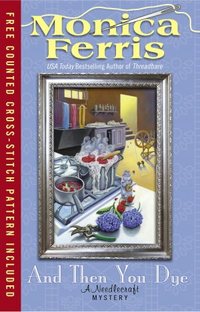 THE DEATH MASK |
 Sunshine, secrets, and swoon-worthy stories—June's featured reads are your perfect summer escape. |

Purchase
Needlecraft Mystery #16 Mystery Cozy Excerpt of And Then You Dye by Monica FerrisCHAPTER ONE The surface of the library table in the Crewel World needlework shop was thickly layered with newspaper over a sturdy plastic sheet. A big kettle and a large, long-handled stainless-steel pot were simmering on a hot plate in the middle of the table, and there was a smell in the moist air as of some kind of unpopular green vegetable cooking. All eight seats at the table were taken and two women and a man were standing, all attentive to a handsome dark-haired woman in her middle fifties enveloped in a white smock generously spattered with soft colors, some faded almost to invisibility. "In dyeing there are two kinds of fibers," she was saying, waving an arm over the pot, "protein fibers and plant fibers. Protein fibers come from animals: wool, silk, alpaca, dog and cat, yak, etcetera." A standing woman's hand went up. "I beg your pardon," she said. "Silk is animal protein?" "Certainly. It comes from the silkworm. And worms – they're moth larvae, actually – are animals." "Oh, the silkworm. Well, yes, I guess they are." But her nose was wrinkled in distaste. "Cotton, linen, soy, bamboo, and corn are some of the plant fibers." She paused, waiting for someone to question that, but no one did. Betsy Devonshire, one of the standees and owner of Crewel World, thought that might be because the speaker was Hailey Brent, whose hand-spun and -dyed yarns, made of all the aforementioned fibers, and more, were familiar to these people, who were customers of Betsy's shop. Hailey looked at the smaller pot on the hot plate. The liquid in it was thick with wilted pinky-lavender flower heads. She picked up a foot-long wooden dowel to stir the mixture. "Just a little longer," she said. In an irregular cluster on the table were four small glass bottles, each containing a powder, one white, one gray-green and two gray. Each carried a white stick-on label with uncial lettering: Tin, Copper, Iron, Alum. "Now, mordants." Hailey gestured at the bottles. "Mordants are chemical or metal salts such as these, dissolved in water. The word comes from a Latin word for ‘bite,' because they cause the dye to penetrate the fiber. Any fibers you are going to dye should first be soaked in one of these mordants. They change the way color from the dye bath affects the fibers. They may also brighten, dull, or strengthen a color, and they all serve to make the dye more colorfast. All the metallic ones are poisonous, which is the main reason why, if you decide to try dyeing, you should absolutely never use a pot or pan or bowl that you use in ordinary cooking. Not even careful washing is guaranteed to restore it to safe food use. I hope that is clear?" Hailey had gone from genial to very serious in her talk, and everyone solemnly nodded back at her. Those who had been taking notes were seen to write this down. Betsy, who had been thinking that dyeing might be an interesting way to spend an afternoon, changed her mind. "Good. Now, let's strain out the vegetable matter from our dyebath." Hailey reached under the table for yet another stainless steel pot, this a big one with two pouring lips. Atop it was a big, deep strainer. She slowly poured the flower heads and the liquid, the color of thin tea, into the strainer, using the dowel to poke the last of the flowers out. "Ms. Brent," asked one of the observers seated at the table, "is that brown the color we're going to get on the wool?" "Possibly. I'm not sure," Hailey replied. "One of the more interesting things about vegetable dyeing is that when you try a new variety, you're never quite sure what color you're going to get. But I don't think we're going to get pink or lavender." "Oh," said someone else in a disappointed voice, "I was hoping for a nice, bright pink." "For a nice, bright pink, I'm afraid you need to go to the aniline dyes – chemical dyes. Natural dyes tend to be softer in color." "But wasn't there a red dye back in the eighteenth century?" asked another woman. "The British used it on its soldiers' uniforms, that's why they were called redcoats, right? And that was before aniline dyes." "There is a natural dye that gives a true red, but it comes from an insect found on Mexican cactus plants: cochineal. It was a very expensive dye – still is, in fact. The British were showing off, using it for ordinary soldiers' uniforms. The closest red you'll get from a vegetable dye is orange. There is actually a local flower that will give you a nice, rich orange, but it isn't fast – it fades in sunlight and after a couple of washings, even when mordanted." "What flower is that?" asked the woman. "A new variety of marigold. You'll probably notice, when we dye our samples, that the wool mordanted in tin gives us the brightest color." Also on the table was a low stack of fabric cut into four-inch squares, each with five short lengths of white yarn slip-knotted through slits cut down one side. Beside each slip of yarn was printed on the fabric with permanent marker: Alum, Copper, Iron, Tin and None. Hailey picked up the squares, counted the number of people present (including herself) and pulled a dozen squares off the stack. Setting them aside, she lifted the strainer off the big pot and dumped the flowers into a waste basket lined with a plastic bag, then poured the liquid back into the pot, putting it back on the burner. "Let's try dyeing some of our wool." She took the dozen squares and dropped them into the pot, poking at them with the dowel. She checked her watch, and half her audience did, too. "We'll give it five minutes," she said. Meanwhile, she lifted the kettle off the hot plate and poured its steaming contents into a stainless steel dishpan. "Rinse water," she explained. She reached under the table and came up with a twin to the pot currently holding the squares. "Betsy, could you fill this about halfway with hot water?" "Certainly," said Betsy, taking the pot with her into the back room, where – having been forewarned – she had earlier filled the electric tea kettle and plugged it in. Hailey Brent had come into Crewel World several months ago to see if Betsy would be interested in carrying her hand-dyed and –spun knitting yarns. Betsy was pleased to add them to her stock and some of her customers were willing to pay the higher prices for the yarns. It was a natural progression for Betsy to invite Hailey to spend an evening in the shop giving a demonstration on dyeing. So here they were on a Thursday evening in late April, learning some of the basics. Betsy poured hot water into the pan and brought it back to the table. Hailey was lifting one of the squares out with her dowel, checking its progress. Already one of the slips of yarn was a dark brown color, one was a bright yellow, one was palest cream, and one was olive-green. The last one, marked "none," was not visibly affected. It was an interesting, seemingly-magical effect to see fibers coming out different colors from the same dyepot. The square itself had turned a pale olive. "None of them is tea colored," said one of the seated women, surprised. "This is what I told you, you never know when you try some new vegetable dye what color you're going to get," said Hailey cheerfully. "I was really hoping for something lavender," remarked another of the sitting women. "I don't see why lavender flowers don't produce a lavender dye." "You know something?" said Hailey with a chuckle. "Neither do I." "Maybe if we used the roots," persisted the woman. "You said earlier that roots can be a source of dye and that you don't always get the color of the roots when you use them as dye." "But we don't have the roots," said Hailey. She added slyly, "Marge evidently didn't dig these up out of someone's garden – did you, Marge?" Marge Schultz, who was standing beside Betsy, turned pink. But she said, calmly enough, "I bought these flowers at the florist shop on Water Street." "You didn't take them from your own gardens?" asked another woman. "No, of course not. These are summer flowers, it's too early in the year for them to bloom in my garden." Marge owned a nursery called Green Gaia Gardens, which Hailey must know about, since she called her so casually by name. Betsy also knew Hailey was herself a gardener, so she must know the lavender daisies wouldn't be blooming in the spring. So why the crack about digging them out of someone's garden? Betsy put the pan of water on the table and Hailey said, "Thanks. This will do for a second rinse. You want to rinse and rinse again and again until the water runs clear." She lifted a square out of the dye, held it over the pot for a little while to let it drip and cool, then very gently squeezed it before putting it in the dishpan. "You want the rinse water to be the same temperature as the dye," she said. "And you don't want to agitate your fibers. Otherwise they may felt." Meaning turn into a solid mat. She continued the process, lifting the other squares one at a time and squeezing them. "There's one mordant I haven't mentioned yet: sugar. Sugar makes a great fixative – that's why if you spill a dollop of jam onto your white trousers, the stain is permanent." She looked up briefly. "Right, Marge? The stain is permanent." The sly tone was even more evident this time. Though her face was still pink, Marge said in a tone bordering on indifference, "How would I know?" One of the seated women offered, "I ruined a favorite blouse last year by spilling blueberry preserves down the front of it." "Why is she picking on you?" murmured Betsy to Marge. "I don't know," Marge said wearily. Betsy asked Marge to stay after the demo was finished. "I lost some of my bleeding hearts over this winter. We used too much salt in the parking lot, I guess. I want to replace them – or maybe get something else that likes shade instead." Betsy owned the old brick building her shop was located in. It was two stories high, and consisted of three stores on the ground floor and three apartments on the second. Betsy lived in one of the apartments herself. In back of the building was a small parking lot just big enough for four cars plus a Dumpster. The parking lot backed onto a steep, tree-filled rise that Betsy owned about two-thirds of. The trees kept the ground in deep shade, and Betsy sometimes thought of having some of them cut down so she could plant some sun-loving perennials back there. She especially envied Marge's collection of hydrangea shrubs. Newly hardy to central Minnesota, hers offered large round clusters of rich pink blooms from June to frost. But they needed lots of sunlight. "I'm wondering what you'd suggest for the hill behind my parking lot," said Betsy. "Did you get a chance to look at it before the dyeing demo?" "Yes, I did. Hostas would look nice, and they spread, so you could only buy a few to start with and then be patient." "Yes, but everyone has hostas. What else is there?" "Well, if you want something large and showy, you should just buy more bleeding hearts. But plant them on the margin of your wooded lot, they do need some sun. For deeper in, and if you want something hard to kill, lily of the valley is a good choice. They spread fast and are very aggressive at driving out other plants, which can be good or bad, depending." They talked about how many plants Betsy should buy and Betsy promised to visit Green Gaia in the next several days. Then Betsy asked, "Marge, what's the problem between you and Hailey Brent?" "Oh, no problem. We just don't get along." "You're neighbors, aren't you?" "Yes. Maybe that's the problem. She has a very artistic temperament, you know." "So?" Marge shrugged uncomfortably. "Well, she has this attitude that anything that drives her artistic sensibilities is permitted. For example, she has come onto my property and stolen flowers. Not a lot, and not often, but when I get something she thinks would make a good dye, she'll take it. She knows it's wrong because she sneaks. I mean, if she really thought it was all right, she'd just take them openly. I asked her one time what if I came into her garden and took a plant I liked? And she said, ‘If you needed it badly, I wouldn't say a word.'" Marge sighed. "One of these days I'll catch her at it and I'll call the police on her." "It's gotten that bad?" Marge sighed again. "No, not really. But she's a terrible nuisance. And now she's got it into her head that I'm just looking for a chance to steal something from her garden – that's what the fuss was this evening. I'm sorry it happened, it must've been at least as aggravating to you as it was embarrassing to me. I only came because was thinking of setting up a little garden of plants useful to dyers and wanted a look at the skill set. And then she behaves like that! Honestly, sometimes I could just brain her!" Marge laughed wryly, but Betsy was to remember this conversation in the weeks to come. Excerpt from And Then You Dye by Monica Ferris |
|
| |||
|
||||




 © 2003-2025
© 2003-2025